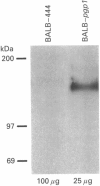Abstract
1. The whole-cell configuration of the patch-clamp technique was used to determine if P-glycoprotein (Pgp) is a swelling-activated Cl- channel. 2. Hamster pgp1 cDNA was transfected into a mouse fibroblast cell line resulting in expression of functional Pgp in the plasma membrane. This cell line was obtained without exposure to chemotherapeutic agents. 3. Swelling-activated whole-cell Cl- current (ICl,swell) was elicited by lowering the bath osmolality. ICl,swell was characterized in detail in the pgp1-transfected mouse cell line and compared with that of its parental cell line. Expression of Pgp did not modify the magnitude or properties of ICl,swell, except that addition of the anti-Pgp antibody C219 to the pipette solution inhibited this current by 75% only in the Pgp-expressing cells. 4. ICl,swell in the mouse Pgp-expressing cell line was compared with that in a Pgp-expressing hamster fibroblast cell line. The characteristics of ICl,swell (voltage dependence, blocker sensitivity, anion selectivity sequence, requirement for hydrolysable ATP) in Pgp-expressing cells were different between the two cell lines. These results suggest that the channel(s) responsible for ICl,swell are different between the two cell lines. In addition, C219 inhibited ICl,swell in both Pgp-expressing cell lines, even though they seem to express different swelling-activated Cl- channels. 5. We conclude that firstly, Pgp is not a swelling-activated Cl- channel; secondly, it possibly functions as a Cl- channel regulator; and thirdly, ICl,swell is underlined by different Cl- channels in different cells.
Full text
PDF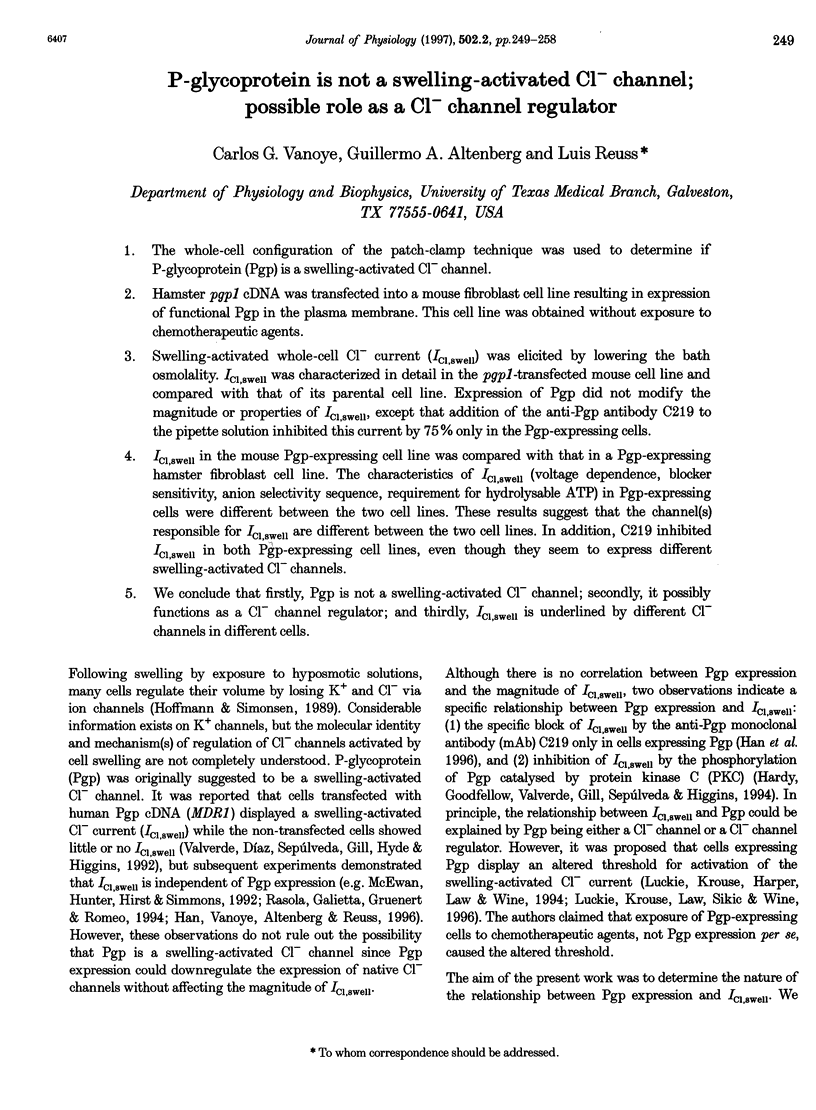
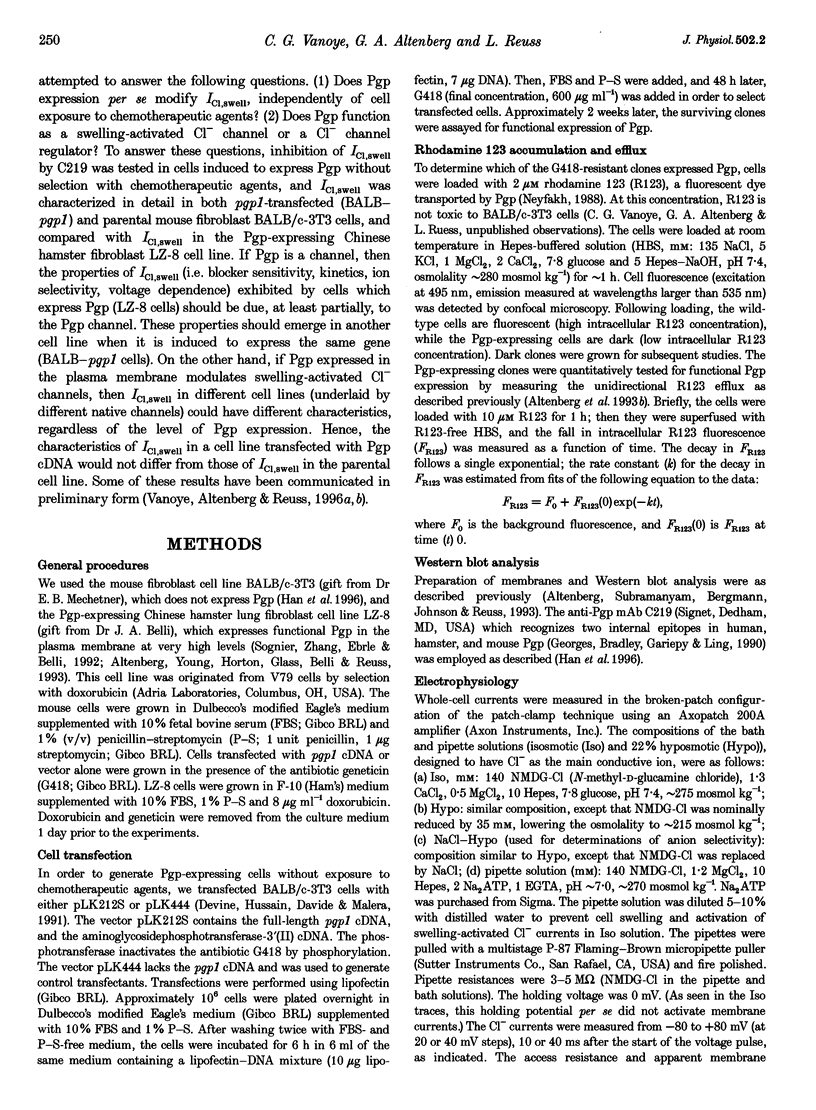
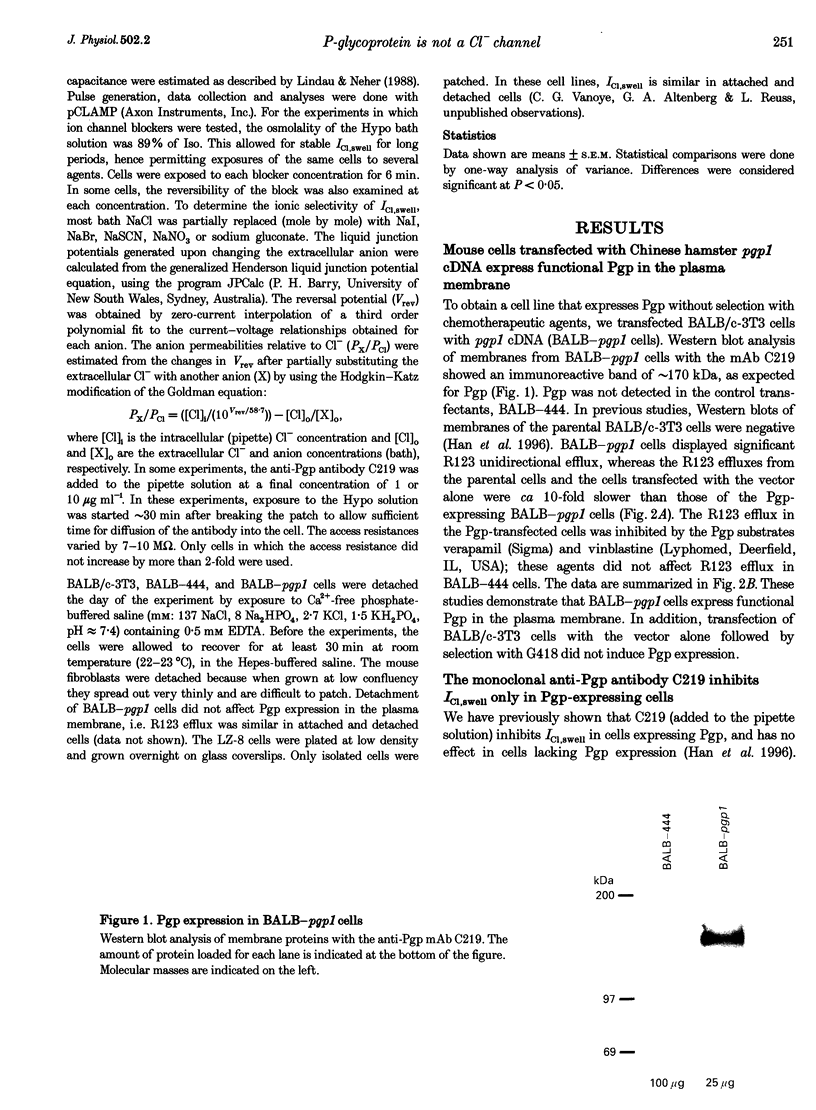
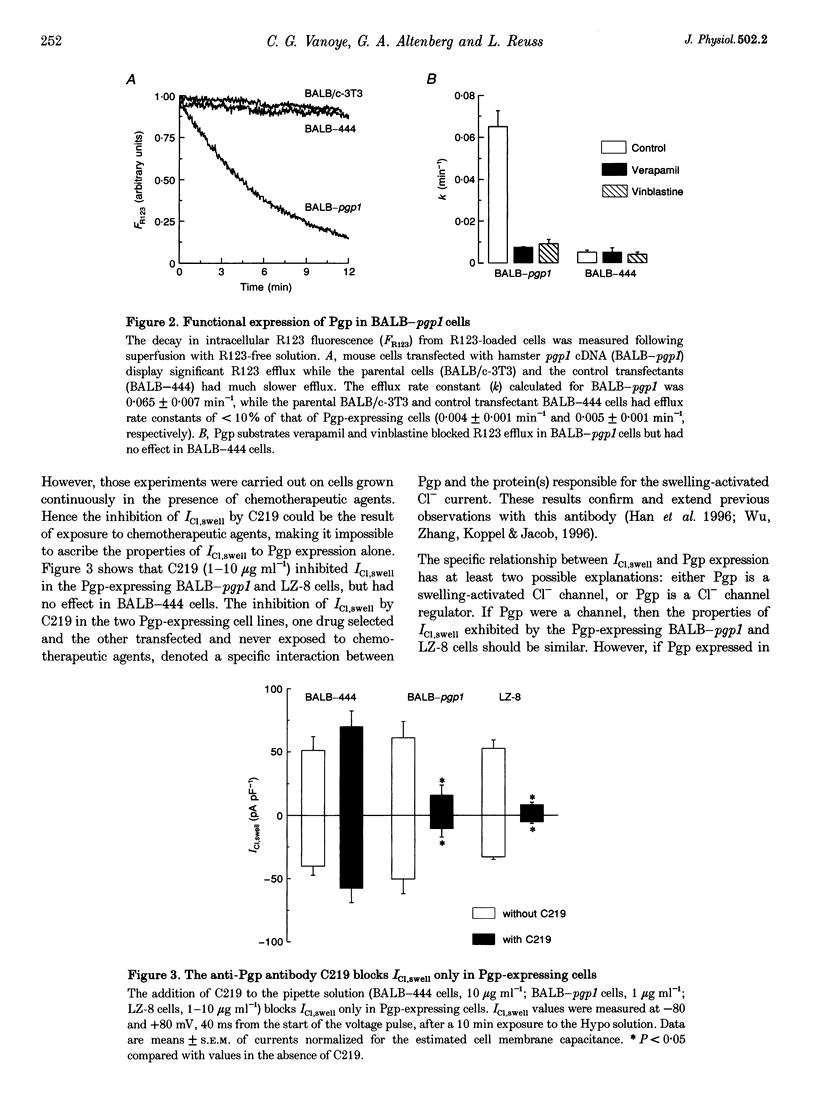
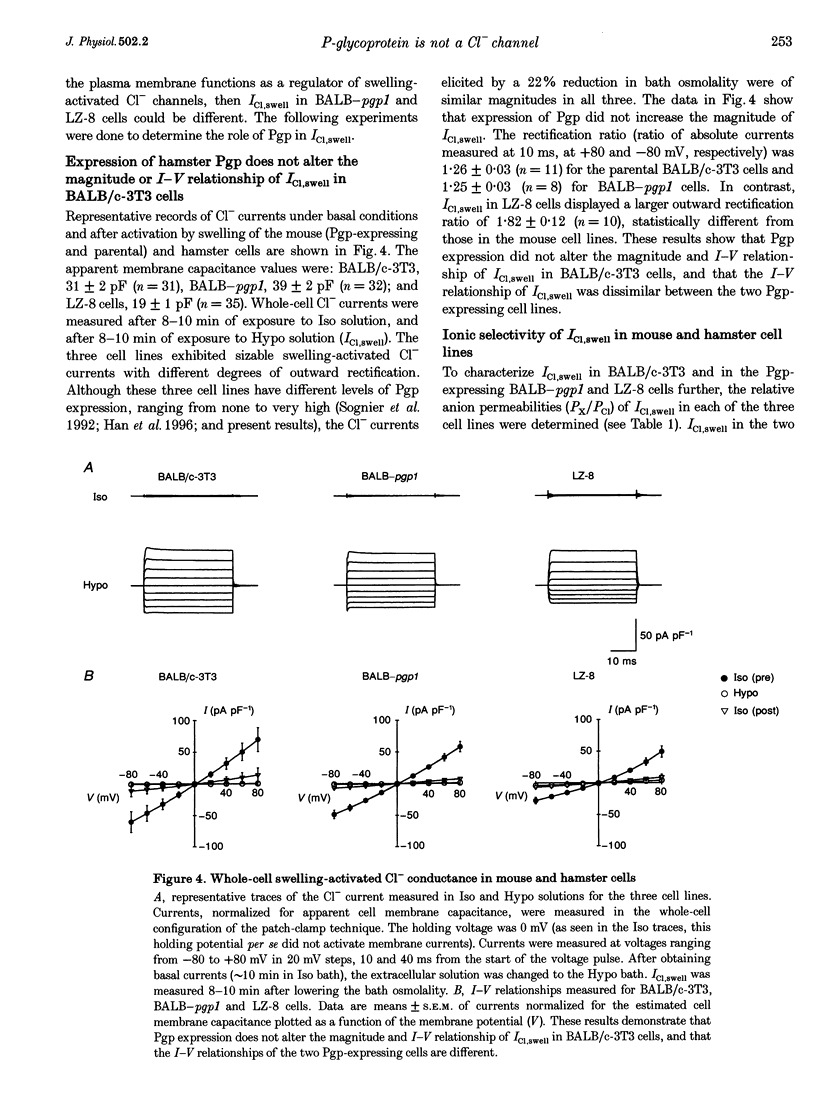
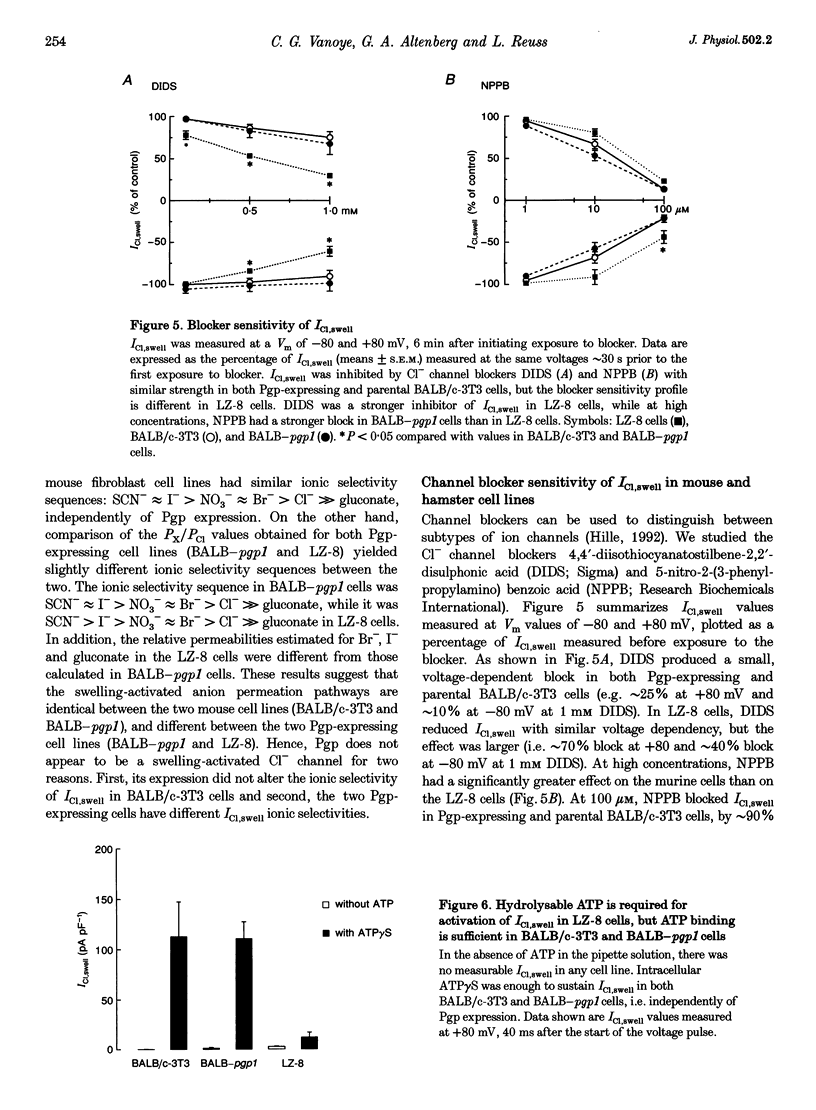
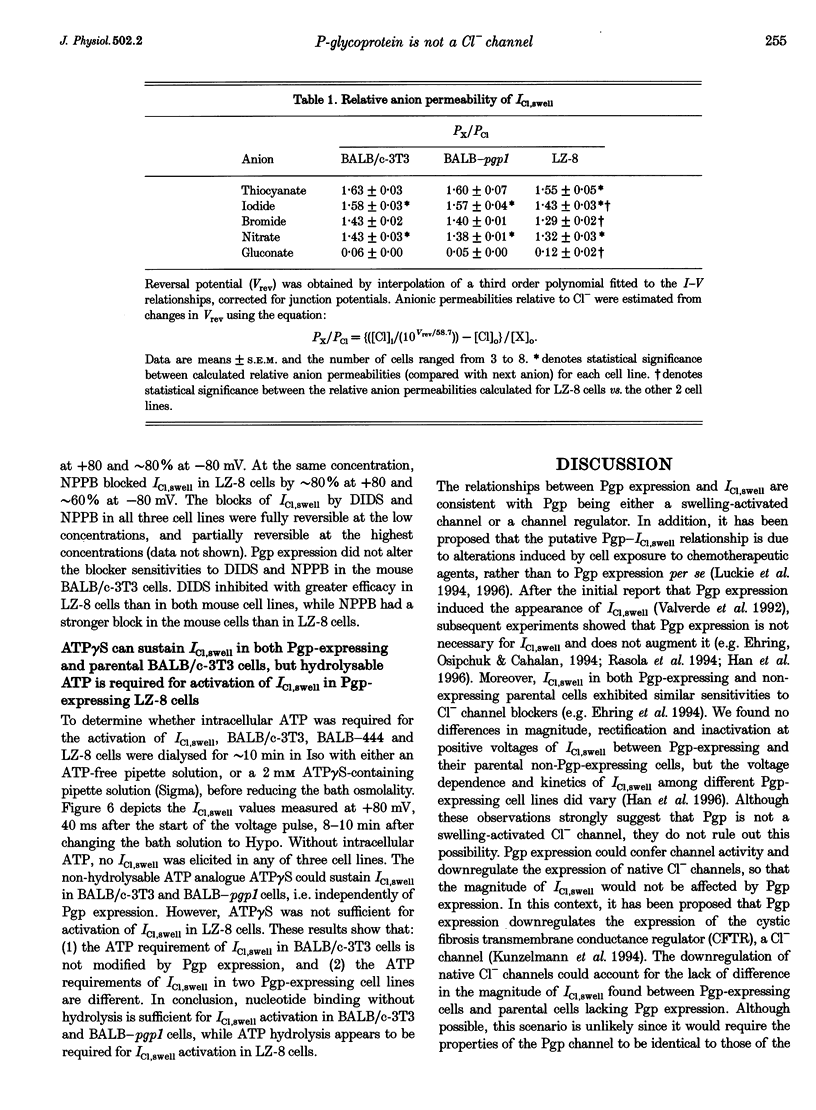
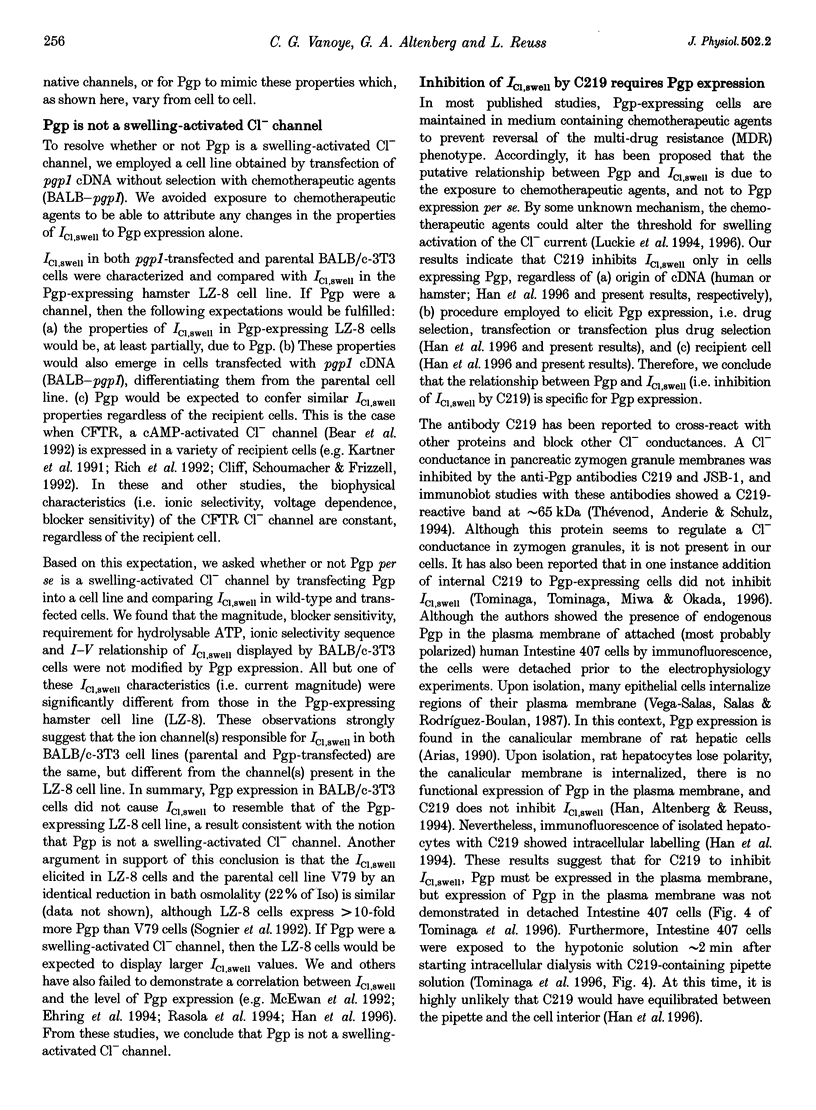
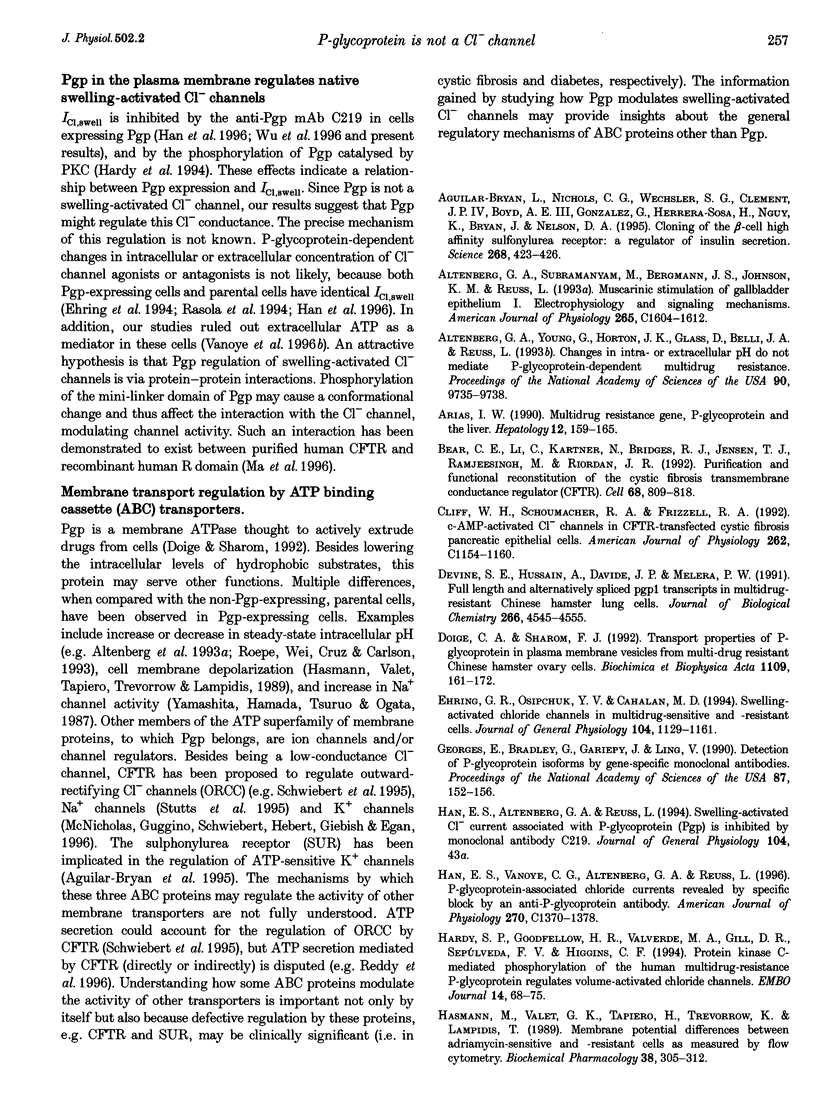
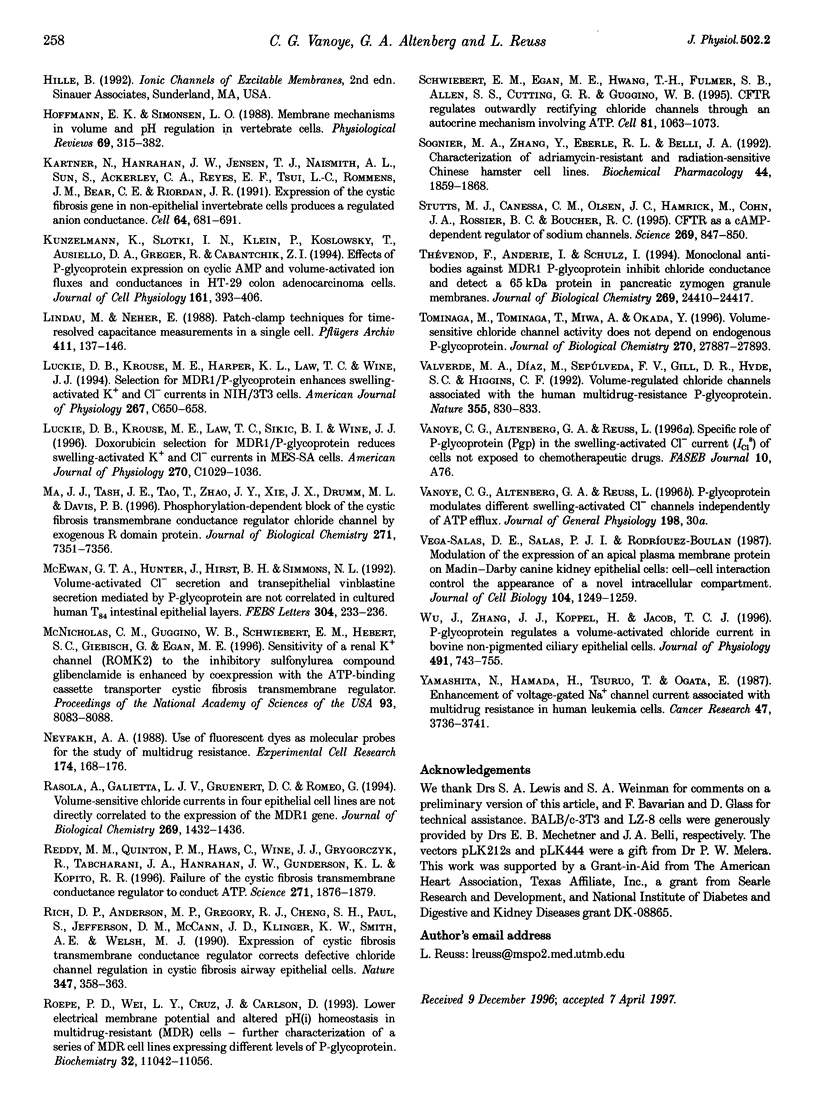
Images in this article
Selected References
These references are in PubMed. This may not be the complete list of references from this article.
- Aguilar-Bryan L., Nichols C. G., Wechsler S. W., Clement J. P., 4th, Boyd A. E., 3rd, González G., Herrera-Sosa H., Nguy K., Bryan J., Nelson D. A. Cloning of the beta cell high-affinity sulfonylurea receptor: a regulator of insulin secretion. Science. 1995 Apr 21;268(5209):423–426. doi: 10.1126/science.7716547. [DOI] [PubMed] [Google Scholar]
- Altenberg G. A., Subramanyam M., Bergmann J. S., Johnson K. M., Reuss L. Muscarinic stimulation of gallbladder epithelium. I. Electrophysiology and signaling mechanisms. Am J Physiol. 1993 Dec;265(6 Pt 1):C1604–C1612. doi: 10.1152/ajpcell.1993.265.6.C1604. [DOI] [PubMed] [Google Scholar]
- Altenberg G. A., Young G., Horton J. K., Glass D., Belli J. A., Reuss L. Changes in intra- or extracellular pH do not mediate P-glycoprotein-dependent multidrug resistance. Proc Natl Acad Sci U S A. 1993 Oct 15;90(20):9735–9738. doi: 10.1073/pnas.90.20.9735. [DOI] [PMC free article] [PubMed] [Google Scholar]
- Arias I. M. Multidrug resistance genes, p-glycoprotein and the liver. Hepatology. 1990 Jul;12(1):159–165. doi: 10.1002/hep.1840120125. [DOI] [PubMed] [Google Scholar]
- Bear C. E., Li C. H., Kartner N., Bridges R. J., Jensen T. J., Ramjeesingh M., Riordan J. R. Purification and functional reconstitution of the cystic fibrosis transmembrane conductance regulator (CFTR). Cell. 1992 Feb 21;68(4):809–818. doi: 10.1016/0092-8674(92)90155-6. [DOI] [PubMed] [Google Scholar]
- Devine S. E., Hussain A., Davide J. P., Melera P. W. Full length and alternatively spliced pgp1 transcripts in multidrug-resistant Chinese hamster lung cells. J Biol Chem. 1991 Mar 5;266(7):4545–4555. [PubMed] [Google Scholar]
- Doige C. A., Sharom F. J. Transport properties of P-glycoprotein in plasma membrane vesicles from multidrug-resistant Chinese hamster ovary cells. Biochim Biophys Acta. 1992 Aug 24;1109(2):161–171. doi: 10.1016/0005-2736(92)90079-2. [DOI] [PubMed] [Google Scholar]
- Ehring G. R., Osipchuk Y. V., Cahalan M. D. Swelling-activated chloride channels in multidrug-sensitive and -resistant cells. J Gen Physiol. 1994 Dec;104(6):1129–1161. doi: 10.1085/jgp.104.6.1129. [DOI] [PMC free article] [PubMed] [Google Scholar]
- Georges E., Bradley G., Gariepy J., Ling V. Detection of P-glycoprotein isoforms by gene-specific monoclonal antibodies. Proc Natl Acad Sci U S A. 1990 Jan;87(1):152–156. doi: 10.1073/pnas.87.1.152. [DOI] [PMC free article] [PubMed] [Google Scholar]
- Han E. S., Vanoye C. G., Altenberg G. A., Reuss L. P-glycoprotein-associated chloride currents revealed by specific block by an anti-P-glycoprotein antibody. Am J Physiol. 1996 May;270(5 Pt 1):C1370–C1378. doi: 10.1152/ajpcell.1996.270.5.C1370. [DOI] [PubMed] [Google Scholar]
- Hardy S. P., Goodfellow H. R., Valverde M. A., Gill D. R., Sepúlveda V., Higgins C. F. Protein kinase C-mediated phosphorylation of the human multidrug resistance P-glycoprotein regulates cell volume-activated chloride channels. EMBO J. 1995 Jan 3;14(1):68–75. doi: 10.1002/j.1460-2075.1995.tb06976.x. [DOI] [PMC free article] [PubMed] [Google Scholar]
- Hasmann M., Valet G. K., Tapiero H., Trevorrow K., Lampidis T. Membrane potential differences between adriamycin-sensitive and -resistant cells as measured by flow cytometry. Biochem Pharmacol. 1989 Jan 15;38(2):305–312. doi: 10.1016/0006-2952(89)90041-5. [DOI] [PubMed] [Google Scholar]
- Hoffmann E. K., Simonsen L. O. Membrane mechanisms in volume and pH regulation in vertebrate cells. Physiol Rev. 1989 Apr;69(2):315–382. doi: 10.1152/physrev.1989.69.2.315. [DOI] [PubMed] [Google Scholar]
- Kartner N., Hanrahan J. W., Jensen T. J., Naismith A. L., Sun S. Z., Ackerley C. A., Reyes E. F., Tsui L. C., Rommens J. M., Bear C. E. Expression of the cystic fibrosis gene in non-epithelial invertebrate cells produces a regulated anion conductance. Cell. 1991 Feb 22;64(4):681–691. doi: 10.1016/0092-8674(91)90498-n. [DOI] [PubMed] [Google Scholar]
- Kunzelmann K., Slotki I. N., Klein P., Koslowsky T., Ausiello D. A., Greger R., Cabantchik Z. I. Effects of P-glycoprotein expression on cyclic AMP and volume-activated ion fluxes and conductances in HT-29 colon adenocarcinoma cells. J Cell Physiol. 1994 Dec;161(3):393–406. doi: 10.1002/jcp.1041610302. [DOI] [PubMed] [Google Scholar]
- Lindau M., Neher E. Patch-clamp techniques for time-resolved capacitance measurements in single cells. Pflugers Arch. 1988 Feb;411(2):137–146. doi: 10.1007/BF00582306. [DOI] [PubMed] [Google Scholar]
- Luckie D. B., Krouse M. E., Harper K. L., Law T. C., Wine J. J. Selection for MDR1/P-glycoprotein enhances swelling-activated K+ and Cl- currents in NIH/3T3 cells. Am J Physiol. 1994 Aug;267(2 Pt 1):C650–C658. doi: 10.1152/ajpcell.1994.267.2.C650. [DOI] [PubMed] [Google Scholar]
- Luckie D. B., Krouse M. E., Law T. C., Sikic B. I., Wine J. J. Doxorubicin selection for MDR1/P-glycoprotein reduces swelling-activated K+ and Cl- currents in MES-SA cells. Am J Physiol. 1996 Apr;270(4 Pt 1):C1029–C1036. doi: 10.1152/ajpcell.1996.270.4.C1029. [DOI] [PubMed] [Google Scholar]
- Ma J., Tasch J. E., Tao T., Zhao J., Xie J., Drumm M. L., Davis P. B. Phosphorylation-dependent block of cystic fibrosis transmembrane conductance regulator chloride channel by exogenous R domain protein. J Biol Chem. 1996 Mar 29;271(13):7351–7356. doi: 10.1074/jbc.271.13.7351. [DOI] [PubMed] [Google Scholar]
- McEwan G. T., Hunter J., Hirst B. H., Simmons N. L. Volume-activated Cl- secretion and transepithelial vinblastine secretion mediated by P-glycoprotein are not correlated in cultured human T84 intestinal epithelial layers. FEBS Lett. 1992 Jun 15;304(2-3):233–236. doi: 10.1016/0014-5793(92)80626-r. [DOI] [PubMed] [Google Scholar]
- McNicholas C. M., Guggino W. B., Schwiebert E. M., Hebert S. C., Giebisch G., Egan M. E. Sensitivity of a renal K+ channel (ROMK2) to the inhibitory sulfonylurea compound glibenclamide is enhanced by coexpression with the ATP-binding cassette transporter cystic fibrosis transmembrane regulator. Proc Natl Acad Sci U S A. 1996 Jul 23;93(15):8083–8088. doi: 10.1073/pnas.93.15.8083. [DOI] [PMC free article] [PubMed] [Google Scholar]
- Neyfakh A. A. Use of fluorescent dyes as molecular probes for the study of multidrug resistance. Exp Cell Res. 1988 Jan;174(1):168–176. doi: 10.1016/0014-4827(88)90152-8. [DOI] [PubMed] [Google Scholar]
- Rasola A., Galietta L. J., Gruenert D. C., Romeo G. Volume-sensitive chloride currents in four epithelial cell lines are not directly correlated to the expression of the MDR-1 gene. J Biol Chem. 1994 Jan 14;269(2):1432–1436. [PubMed] [Google Scholar]
- Reddy M. M., Quinton P. M., Haws C., Wine J. J., Grygorczyk R., Tabcharani J. A., Hanrahan J. W., Gunderson K. L., Kopito R. R. Failure of the cystic fibrosis transmembrane conductance regulator to conduct ATP. Science. 1996 Mar 29;271(5257):1876–1879. doi: 10.1126/science.271.5257.1876. [DOI] [PubMed] [Google Scholar]
- Rich D. P., Anderson M. P., Gregory R. J., Cheng S. H., Paul S., Jefferson D. M., McCann J. D., Klinger K. W., Smith A. E., Welsh M. J. Expression of cystic fibrosis transmembrane conductance regulator corrects defective chloride channel regulation in cystic fibrosis airway epithelial cells. Nature. 1990 Sep 27;347(6291):358–363. doi: 10.1038/347358a0. [DOI] [PubMed] [Google Scholar]
- Schwiebert E. M., Egan M. E., Hwang T. H., Fulmer S. B., Allen S. S., Cutting G. R., Guggino W. B. CFTR regulates outwardly rectifying chloride channels through an autocrine mechanism involving ATP. Cell. 1995 Jun 30;81(7):1063–1073. doi: 10.1016/s0092-8674(05)80011-x. [DOI] [PubMed] [Google Scholar]
- Sognier M. A., Zhang Y., Eberle R. L., Belli J. A. Characterization of adriamycin-resistant and radiation-sensitive Chinese hamster cell lines. Biochem Pharmacol. 1992 Nov 3;44(9):1859–1868. doi: 10.1016/0006-2952(92)90082-t. [DOI] [PubMed] [Google Scholar]
- Stutts M. J., Canessa C. M., Olsen J. C., Hamrick M., Cohn J. A., Rossier B. C., Boucher R. C. CFTR as a cAMP-dependent regulator of sodium channels. Science. 1995 Aug 11;269(5225):847–850. doi: 10.1126/science.7543698. [DOI] [PubMed] [Google Scholar]
- Thévenod F., Anderie I., Schulz I. Monoclonal antibodies against MDR1 P-glycoprotein inhibit chloride conductance and label a 65-kDa protein in pancreatic zymogen granule membranes. J Biol Chem. 1994 Sep 30;269(39):24410–24417. [PubMed] [Google Scholar]
- Tominaga M., Tominaga T., Miwa A., Okada Y. Volume-sensitive chloride channel activity does not depend on endogenous P-glycoprotein. J Biol Chem. 1995 Nov 17;270(46):27887–27893. doi: 10.1074/jbc.270.46.27887. [DOI] [PubMed] [Google Scholar]
- Valverde M. A., Díaz M., Sepúlveda F. V., Gill D. R., Hyde S. C., Higgins C. F. Volume-regulated chloride channels associated with the human multidrug-resistance P-glycoprotein. Nature. 1992 Feb 27;355(6363):830–833. doi: 10.1038/355830a0. [DOI] [PubMed] [Google Scholar]
- Wu J., Zhang J. J., Koppel H., Jacob T. J. P-glycoprotein regulates a volume-activated chloride current in bovine non-pigmented ciliary epithelial cells. J Physiol. 1996 Mar 15;491(Pt 3):743–755. doi: 10.1113/jphysiol.1996.sp021254. [DOI] [PMC free article] [PubMed] [Google Scholar]
- Yamashita N., Hamada H., Tsuruo T., Ogata E. Enhancement of voltage-gated Na+ channel current associated with multidrug resistance in human leukemia cells. Cancer Res. 1987 Jul 15;47(14):3736–3741. [PubMed] [Google Scholar]



